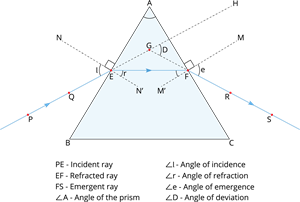
PUMPA - SMART LEARNING
எங்கள் ஆசிரியர்களுடன் 1-ஆன்-1 ஆலோசனை நேரத்தைப் பெறுங்கள். டாப்பர் ஆவதற்கு நாங்கள் பயிற்சி அளிப்போம்
Book Free DemoIn the previous section, we have learned the refraction of light through a glass slab. In this section, we will discuss the refraction of light through a glass prism.

Refraction of light through a glass prism
In the above diagram, \(PE\) is the incident ray, \(EF\)is the refracted ray, and \(FS\) is the emergent ray.
We may observe that a ray of light enters from air to glass at the first surface \(AB\). The light ray on refraction has bent towards the normal.
At the second surface \(AC\), the light ray has entered from glass to air. Hence, it has bent away from normal.
Here,
\(\angle i\) \(-\) \(Angle\ of\ incidence\)
\(\angle r\) \(-\) \(Angle\ of\ refraction\)
\(\angle e\) \(-\) \(Angle\ of\ emergence\)
\(\angle D\) \(-\) \(Angle\ of\ deviation\)
Is this similar to the kind of bending that occurs in a glass slab?
The peculiar shape of the prism makes the emergent ray bend at an angle to the direction of the incident ray. This angle is called the angle of deviation.
In this case, \(\angle D\) is the angle of deviation.